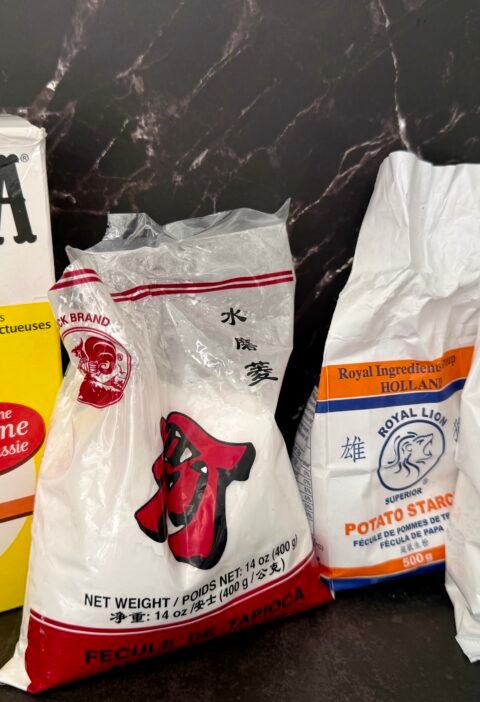When we adopt a gluten -free , the choice of flours and starchs becomes essential to guarantee balanced nutrition, avoid deficiencies and maintain a low glycemic index .
I had already written an article on gluten-free flours but in it I will emphasize the nutritional interest of each. In this article, we will explore the best gluten -free alternatives , their nutritional benefits and their ideal use in the kitchen.
Why choose the right gluten -free flours and stucle?
Unlike wheat flour, which contains gluten and often high glycemic index , some gluten -free flours are richer in fiber, proteins, iron, magnesium and zinc . They therefore make it possible to maintain a balanced diet while avoiding blood sugar peaks.
However, not all gluten -free flours and stuculas are equal! Some are more nutritious than others , and their combination makes it possible to obtain optimal textures and flavors in the kitchen.
The rice flour , which we use frequently, is not bad for health, but it must be consumed in moderation, especially in refined form. For a more balanced diet, it is preferable to favor complete rice flour , richer in fiber, to associate it with other more nutritious flours (buckwheat, chickpea, almond) to balance the nutrient intake, to accompany it with proteins and good fats to slow the absorption of carbohydrates. And above all to avoid excessive consumption , especially if you try to regulate your blood sugar.
The best gluten -free flour for health
🥖 For bread: favor flour rich in protein and fiber
| Flour | Benefits |
|---|---|
| Buckwheat | Rich in complete protein and fibers, low glycemic index |
| Teff | Rich in iron, calcium, potassium, good for digestion |
| Quinoa flour | Complete proteins, magnesium, iron and vitamins B |
| Chickpea flour | Excellent source of vegetable proteins and iron |
| Arrow-Rot Starch | Help to lighten the texture, good digestibility |
💡 Ideal mixture for gluten-free bread :
50% buckwheat flour + 30% Teff flour + 20% Arrow-Root starch for a good texture and better digestibility.
🧁 For pastry: soft and nutritious flours
| Flour | Benefits |
|---|---|
| Almond flour | Low in carbohydrates, rich in good lipids and fibers |
| Coconut flour | Very rich in fiber, helps with satiety, ig low |
| Chestnut flour | Naturally sweet, rich in minerals and antioxidants |
| Tapioca starch | Brings softness and good outfit |
| Chickpea flour | Brings a firm and balanced texture |
💡 Ideal mixture for light and gourmet pastry :
40% almond flour + 40% chestnut flour + 20% tapioca starch .
🥣 To thicken sauces, creams and soups (cornstarch substitutes)
| Starch / flour | Benefits |
|---|---|
| Arrow-Rot Starch | Ig low, very digestible, ideal for sauces and creams |
| Tapioca starch | Thickened without weighing down, but to limit alone |
| Chickpea flour | Can replace classic flour in sauces |
| Teff | Gives a beautiful texture to thick soups and sauces |
🥧 For quiches and savory pies: good hold and softness
| Flour | Benefits |
|---|---|
| Chickpea flour | Good hold, rich in protein and iron |
| Buckwheat | Excellent for a rustic texture and a pronounced taste |
| Almond flour | Brings softness and a slight sweet taste |
| Arrow-Rot Starch | Gives lightness to the quiche device |
💡 Ideal mixture for a soft-free quiche :
60% chickpea flour + 30% almond flour + 10% Arrow-root starch .
🥞 For pancakes and pancakes: fluidity and lightness
| Flour | Benefits |
|---|---|
| Buckwheat | Ideal for salted pancakes, rich in protein and low GI |
| Chestnut flour | Perfect for slightly sweet and gourmet pancakes |
| Full rice flour | Provides lightness but beware at the highest GI |
| Arrow-Rot Starch | Allows a more fluid and homogeneous paste |
| Chickpea flour | Good option for thick salted pancakes |
💡 Ideal mixture for gluten-free sweet pancakes :
50% chestnut flour + 40% buckwheat flour + 10% Arrow-Root starch .
💡 Ideal mixture for gluten-free savory pancakes :
50% chickpea flour + 40% buckwheat flour + 10% Arrow-Root starch .
Comparison of flours according to their nutrient content
| Flour | B vitamins | Iron (mg/100g) | Magnesium (mg/100g) | Zinc (mg/100g) |
|---|---|---|---|---|
| Teff | B1, B2, B3, B6 | 5,4 | Pupil | Pupil |
| Buckwheat | B6 | 2,1 | 231 | 2,4 |
| Quinoa flour | B1, B2, B6, B9 | 4,6 | 197 | 2,7 |
| Chickpea flour | B1, B6, B9 | 4,5 | 152,7 | 2,6 |
| Almond flour | B2, B3 | 3,7 | 268 | 3,1 |
| Coconut flour | Few b | 3,3 | 90 | 2,3 |
💡 The best flours for minerals :
- Iron: Teff and Quinoa
- Magnesium: buckwheat and almond
- Zinc: quinoa and chickpea
Conclusion: which flours and stuculates to choose?
1️⃣ If you want flours rich in nutrients :
- Teff flour (iron, calcium)
- Buckwheat flour (magnesium, proteins)
- Chickpea flour (protein, iron, vitamins B)
2️⃣ If you are looking to avoid blood sugar peaks :
- Buckwheat flour, teff and chickpeas (ig low)
- Arrow-root starch (healthier alternative to cornstarch)
3️⃣ If you like fluffy textures in pastry :
- Almond flour, chestnut flour and coconut flour
❌ To limit or balance:
- White rice flour : high glycemic index, few fibers
- Corn flour : not very nutritious and can be inflammatory if consumed in excess
- Potato starch : very high IG, little nutritional interest
💡 Health tip : Always mix several flours to get a perfect texture and an optimal nutritional intake!
👉 What is your favorite gluten -free flour? Say him in comment! 😊







